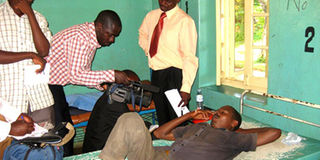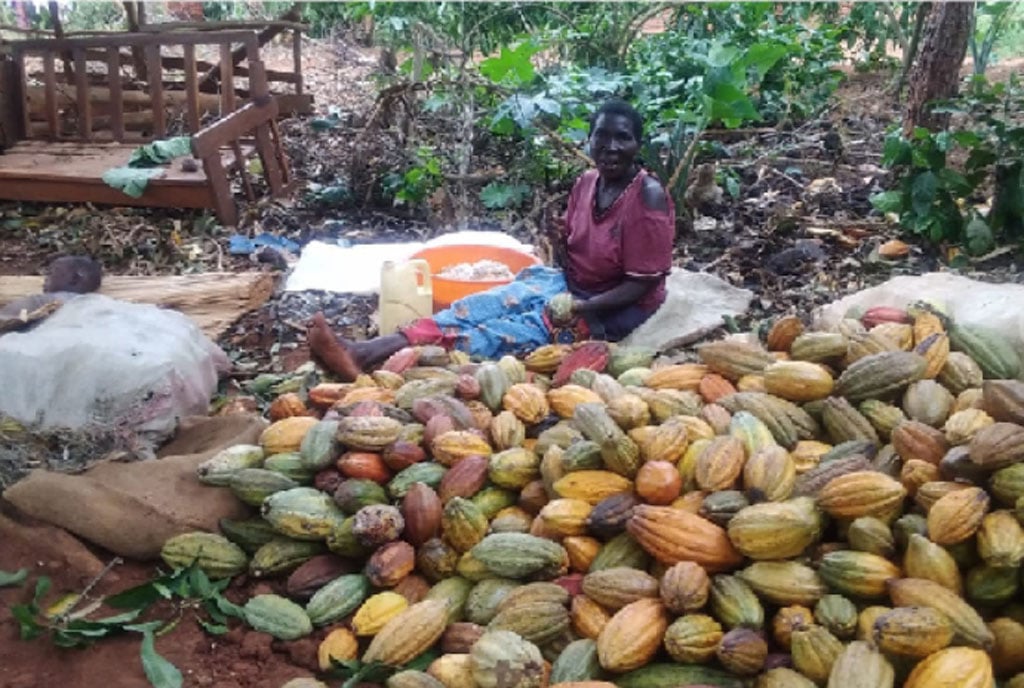When African brewers ferment death

LOST SIGHT: Mr Azizi Akunda took a local gin in Kalangala and became blind as another victim who took chang’aa at Shauri Moyo, Kenya cries for help. FILE PHOTOS
Since last month, contaminated alcohol has killed 89 Ugandans in Kabale and Kamwenge districts and left over 100 hospitalised. A fortnight ago, a lethal brew killed nine Kenyans in the Shauri Moyo section of Nairobi. Such deaths are nothing new with memories of a similar tragedy in Kisaasi, a Kampala suburb and eastern Kenya last year, still fresh in the minds of residents. BETTY KYAKUWA AND KAMAU MUTUNGA look at traditional brews in Africa:-
African societies have proverbs for every situation, drinking included. Nigerians say: “He who is drunk from palm wine can sober up, he who is drunk from wealth cannot.”
Such proverbs and wise sayings on alcohol were invariably about men, since in most traditional settings, drinking was primarily an indulgence of the adult male.
But this is no longer true. Back home, Women and children have been casualties to the waragi which officials say is mixed with methanol.
A two-year old child in Kabale District, was on Monday admitted to Kabale Referral Hospital in critical condition after allegedly consuming alcohol spiked with methanol. Methanol, an industrial alcohol, is used in products such as anti-freezants and if absorbed directly into the blood stream, leads to coma, blindness and death.
According to the baby’s grandmother, the child picked the alcohol in an abandoned sachet from a nearby bush where the drinkers had hidden it. However, unconfirmed reports indicated that the baby might have been given the drink by a customer at a bar near its home.
African drinks, most of them illicit, come with quirky, drunken names. While Kenya has chang’aa or “kill-me-quick,” Botswana takes the gold in naming its backyard brews. It has tho-tho-tho, (the dizzy spell), a lala fa (you sleep right here), laela mmago (say goodbye to your mother) chechisa (hurry up) and motes o teng godimo (there is home in heaven).
DR Congo can claim silver with kasiki (I regret,) and mokoyo (the dog that bites.)
If there was a medal higher than gold, Uganda would win hands down. According to the 2010 World Health Organisation report on Global Status Report on Alcohol, Uganda has the highest per capita consumption of alcohol in the world, with Luxembourg and the Czech Republic, staggering closely behind. Ugandans spend $145 million (Shs300 billion) on alcohol annually, according to the report.
The country with waragi as its most popular drink has upset African champions Zambia where 42.3 per cent of its imbibers begin boozing between the ages 13 and15.
Crucial alcohol
These suggestive names and statistics notwithstanding, home-made brews boast a frothy history in most African societies. Alcohol was used to appease ancestors as libation, loosen tongues during slippery dowry negotiations and to celebrate new seasons or victory in war. Then there were drinking sessions to celebrate births, mending rifts between warring factions and repentance. Or simply to while away time.
Among the Kofyar people of Jos Nigeria, for instance, presenting a brew was viewed as an act of affection and respect. Alcohol, give or take, had blessed status in Africa irrespective of class community or geography.
In pre-colonial Africa, drinks were fermented --- not distilled. The Kikuyu of Kenya brewed and still brew muratina from honey and sugarcane, the Swahili at the Kenyan Coast have their mnazi fermented from the coconut fruit. South Africa has chibuku and umqomboti. Botswana has khadi, Central Africa Republic hydromel and Ethiopia araque, or katila, which has high alcohol content and is pricier than bottled beer.
More names
Botswana, Zambia, and Malawi all have chibuku shake-shake, so called because drinkers have to shake it before drinking. In Zimbabwe, shake shake is called “scud.” Ghana has burukutu and akpeteshie, the latter was so popular in colonial Gold Coast that it replaced imported spirits. Now, it’s the preserve of poor Ghanaians.
In Uganda, the Baganda brew their tonto from bananas, the Iteso brew ajon from millet. In western Uganda, while some Bakiga still stagger on the strength of omuramba fermented from sorghum, for others the drink is not strong enough. It is this that has evoked innovation. Officials say the residents have resorted to mixing the local brew with other spirits and methanol.
Following a crackdown on people consuming the poisonous drink, residents are now playing tricks on the officials. Dr Patrick Tusiime, the district health officer, says dealers have resorted to selling the banned crude waragi in beer bottles in a bid to avoid law enforcers, while other people are consuming it behind locked doors.
Ms Scovia Hakyiri, 28, a resident of Omukazinde Kitumba Sub-county, in western Uganda regrets taking the local brew that left her blind.
She is admitted at Rugarama Hospital where medical personnel say she is not improving and is no likely to regain her sight. And even though seeing double was an occasional menace, traditional brews rarely killed, and certainly didn’t blind as modern ‘poisons’ do.
Colonialism introduced foreign drinks to Africa. But its onset in most parts of Africa corked brews up. Liquor laws were enacted banning “natives” from consuming bottled beer, or issuing Africans with liquor licences, preferring to allow indulgences during specific ceremonies and rites on the strength of a letter from a stern-faced chief. After independence, African governments upheld the colonial liquor laws. For many countries, traditional brews were deemed “illicit” since their distillation and lack of packaging fell outside government and public health regulations.
However, Uganda legalised waragi, which derives its name from “war gin” as the British colonial expatriates called it in the ‘50s and ‘60s. The Baganda call it enguli and in 1965, “The Enguli Act,” decreed that distillation be licenced.
Only customer
Distillers were to sell the drink that is brewed from cassava, bananas, millet and sugarcane to the then government-run Uganda Distilleries Ltd, which bottled, branded and marketed it under the name, Uganda Waragi.
But unlicensed production of waragi, also called “regular” or “crude” continues under names such as the cassava-derived lira-lira and kasese, a potent banana gin. Both are named after the towns where they’re brewed.
The government is set to act and replace it with a broader law to regulate, develop and promote the beer industry. The new policy will form the basis for replacing the 1965 Enguli Act.
The Deputy Executive Director Uganda National Bureau of Standards (UNBS), Mr Mackay Aomu, says the bureau is carrying out scientific tests on the liquor impounded by the Kabale district security and health teams in an ongoing crack down on the killer drink.
According to a report, the samples collected from Kabale have levels of methanol of between 170-300 more times the allowable limit. The maximum allowable level of methanol in waragi is 0.05 per cent M/V.
“We are on the ground and initial results show that the alcohol was contaminated,” Mr Aomu said. The Ministry of Trade and Industry is working to establish a national spirits consumption policy to regulate and manage consumption.
Tougher legislation
Kenya on the other hand passed a by-law making it illegal to sell or consume chang’aa. A bill aimed at controlling alcohol advertising has also been tabled in the Kenyan Parliament.
The WHO reports that regulating illicit brews totters off the intended path because many African countries have a myriad political, economic and health crises, and controlling killer brews is not a priority. Critics have argued that this is because of the high revenue that alcohol companies remit to the government.
In Uganda, the beverage industry is one of the biggest contributors of revenue with beer companies having contributed Shs168.7 billion last financial year.
See Africareview.com for related stories
Africa Insight is an initiative of the Nation Media Group’s Africa Media Network Project.




